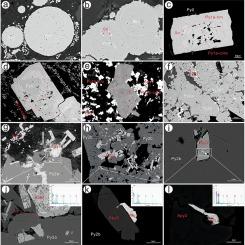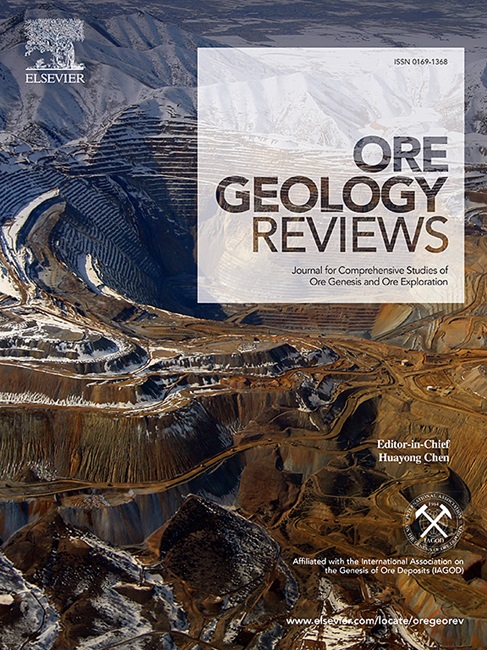西藏南部布珠成因金(锑)矿床多期硫化物的原位痕量元素和硫同位素组成:对成矿过程的影响
IF 3.2
2区 地球科学
Q1 GEOLOGY
引用次数: 0
摘要
布珠金(锑)矿床位于特提斯喜马拉雅山带西藏南部的金锑多金属矿带上,是最近发现的一个中型金多金属矿床。矿体主要由含金石英硫化物矿脉组成。目前,该矿床的成矿机制在很大程度上仍未探明。利用主要矿石矿物的矿物学观察、LA-ICP-MS微量元素分析和黄铁矿的原位硫同位素分析结果,研究重建了黄铁矿-砷黄铁矿的演化过程,并对布珠金(锑)矿床的成矿过程进行了约束。研究发现,布珠金(锑)矿床中的含金硫化物主要是黄铁矿和砷黄铁矿。黄铁矿可分为六代:框沸黄铁矿Py0、溶蚀腔黄铁矿Py1a(有些呈振荡带状)、弥散黄铁矿Py1b、八面体黄铁矿Py2a、不规则黄铁矿Py2b和Py3。另一方面,砷黄铁矿可分为三代:早期砷黄铁矿 Apy0、弥散砷黄铁矿 Apy1 和八面体砷黄铁矿 Apy2。黄铁矿在整个成矿过程中的δ34S分析表明,硫来自多个来源,其中Py0表明硫来源于生物。痕量元素分析表明,黄铁矿的演化过程表明,剩余的黄铁矿来自沉积流体的转化,硫主要来自变质沉积物。元素谱分析和 BSE 观察表明,布珠金(锑)矿床主要经历了两个不同的成矿阶段:初始阶段是金锑成矿阶段,在这一阶段,锑以闪锌矿的形式沉淀在 Py1a 的裂隙中,而金则主要以隐形金的形式存在于 Py1-Apy1 中,其中 Apy1 中的金含量最高(28.20-60.13 ppm,平均 40.51 ppm)。随后的成矿阶段以金成矿为特征,金主要以微米银金矿的形式赋存于 Apy2 的内部裂隙中。含金硫化物的演化特征和金的溶解度曲线表明,金主要来源于含金的不饱和流体,而不是早期的框架黄铁矿 Py0(0.52-1.06 ppm,平均 0.79 ppm)。Py0 中只有一小部分金(源自早期沉积物)被释放出来,并融入到后续的黄铁矿中。Py0 中的锑含量在溶解后明显降低,表明锑主要来源于 Py0(百万分之 206-440,平均百万分之 335)。在布珠金(锑)矿床的整个成因过程中,金成分经历了预富集、再富集、解放和沉淀等一系列过程。溶解-再沉淀(CDR)和沸腾耦合过程促进了金的再活化和再富集。重结晶成立方黄铁矿导致金从黄铁矿晶格中排出,多级流体沸腾产生的流体氧化,加上硫富集度的降低,导致了金的沉淀。本文章由计算机程序翻译,如有差异,请以英文原文为准。

In-situ trace element and sulfur isotope compositions of Multi-Stage sulfides in the Buzhu orogenic gold (Antimony) Deposit, southern Tibet: Implications for the metallogenic process
The Buzhu gold (antimony) deposit, located within the gold-antimony polymetallic belt of southern Tibet in the Tethys Himalayan belt, is a recently discovered medium-sized gold polymetallic deposit. The orebody consists primarily of gold-bearing quartz sulfide veins. Currently, the metallogenic mechanism of the deposit remains largely unexplored. Utilizing results from the mineralogical observation of principal ore minerals, LA-ICP-MS trace element analysis, and in-situ sulfur isotope analysis of pyrite, investigations reconstruct the evolution process of pyrite-arsenopyrite and constrain the metallogenic process of the Buzhu gold (antimony) deposit. It has been discovered that the gold-bearing sulfides in the Buzhu gold (antimony) deposit are primarily pyrite and arsenopyrite. Pyrite can be categorized into six generations: framboidal pyrite Py0, dissolution cavity pyrite Py1a (some exhibiting oscillatory zoning), disseminated pyrite Py1b, euhedral pyrite Py2a, irregular pyrite Py2b, and Py3. Arsenopyrite, on the other hand, can be classified into three generations: early arsenopyrite Apy0, disseminated arsenopyrite Apy1, and euhedral Apy2. The analysis of δ34S in pyrite throughout the ore-forming process indicates sulfur derives from multiple sources, with Py0 indicative of a biological sulfur source. The evolutionary process of pyrite, supported by trace element analysis, suggests that the remaining pyrite derives from sedimentary fluid transformation, with sulfur primarily sourced from metamorphic sediments. Elemental spectrum analysis and BSE observations indicate that the Buzhu gold (antimony) deposit primarily undergoes two distinct stages of mineralization: the initial stage is the gold-antimony mineralization phase, during which antimony precipitates in the fissures of Py1a as stibnite, while gold is primarily found in Py1-Apy1 as invisible gold, with the highest gold content in Apy1 (28.20–60.13 ppm, average 40.51 ppm). The subsequent stage of mineralization is characterized by gold mineralization, with gold primarily residing in the internal fissures of Apy2 as micron silver gold ore. The evolution characteristics of gold-bearing sulphide and the solubility curve of Au indicate that gold mainly derives from gold-bearing unsaturated fluid, rather than from early framboidal pyrite Py0 (0.52–1.06 ppm, average 0.79 ppm). Only a minor fraction of gold (originating from early sediments) in Py0 was liberated and integrated into subsequent pyrites. The content of antimony in Py0 significantly reduces after dissolution, suggesting that antimony predominantly originates from Py0 (206–440 ppm, average 335 ppm). Throughout the genesis of the Buzhu gold (antimony) deposit, the gold constituent underwent a sequence of pre-enrichment, re-enrichment, liberation, and precipitation. The processes of coupled dissolution-reprecipitation (CDR) and boiling fostered the reactivation and reenrichment of gold. The recrystallization into cubic pyrite led to the expulsion of gold from the pyrite lattice, and fluid oxidation resulting from multistage fluid boiling, coupled with a decrease in sulfur fugacity, led to gold precipitation.
求助全文
通过发布文献求助,成功后即可免费获取论文全文。
去求助
来源期刊

Ore Geology Reviews
地学-地质学
CiteScore
6.50
自引率
27.30%
发文量
546
审稿时长
22.9 weeks
期刊介绍:
Ore Geology Reviews aims to familiarize all earth scientists with recent advances in a number of interconnected disciplines related to the study of, and search for, ore deposits. The reviews range from brief to longer contributions, but the journal preferentially publishes manuscripts that fill the niche between the commonly shorter journal articles and the comprehensive book coverages, and thus has a special appeal to many authors and readers.
 求助内容:
求助内容: 应助结果提醒方式:
应助结果提醒方式:


